SMTP Explained: Everything You Need to Know
About Email Protocols
About Email Protocols
SMTP (Simple Mail Transfer Protocol) is essential for reliable email communication, facilitating the sending and receiving of messages whenever you click send. It underpins various activities, from email marketing to business proposals and customer service interactions. This guide will thoroughly examine SMTP, detailing its operations, key functions, and the importance of grasping its principles for both businesses and individuals.
What is SMTP?
SMTP (Simple Mail Transfer Protocol) is the primary protocol for transmitting emails over the internet. It governs the transfer of messages between servers, ensuring accurate delivery to recipients. In contrast to protocols like IMAP or POP3, which are designed for receiving emails, SMTP is dedicated solely to sending them.

How SMTP Works: The Process of Sending Emails
SMTP functions through a sequence of commands and responses exchanged between the client—like Gmail or Outlook—and the email server. Below is an overview of the SMTP process.
- Mail Submission: When an email is dispatched, the client, such as Gmail, utilizes the sender's credentials to establish a connection with an SMTP server.
- Connection to Recipient’s Server: The SMTP server connects to the recipient's email server, recognizing both the sender and receiver.
- Routing the Email: SMTP operates through a network of relays, allowing several SMTP servers to facilitate email routing, particularly when the recipient's domain differs from that of the sender. The email navigates through these relays until it arrives at its intended destination.
- Delivery: After delivery to the recipient's server, the email is held for retrieval through protocols such as IMAP or POP3.
- Error Handling: In the event of undeliverable email, the SMTP server notifies the sender with a bounce-back message detailing the cause of the failure, such as an invalid email address.
SMTP Components: The Building Blocks of Email Transfer
For SMTP to function efficiently, several components work together:
- Mail User Agent (MUA): This is your email client, such as Outlook, Gmail, or Thunderbird, which composes and sends emails.
- Mail Transfer Agent (MTA): The Mail Transfer Agent is responsible for routing the emails from one server to another.
- Mail Delivery Agent (MDA): This server receives emails from the MTA and stores them for the recipient.
- SMTP Server: The server responsible for receiving the sender’s message and delivering it to the recipient’s server.
Why SMTP Is Important for Businesses
For businesses, grasping the fundamentals of SMTP is essential, particularly when managing high volumes of emails for marketing, customer support, or internal communications. SMTP servers are crucial for ensuring that emails successfully reach their intended recipients and avoid spam filters.
Companies can opt for dedicated SMTP servers or utilize third-party providers to manage extensive email campaigns. These services typically include advanced functionalities such as bounce handling, email tracking, and authentication protocols (SPF, DKIM, DMARC) to enhance security and minimize the risk of messages being flagged as spam. www.duocircle.com is your go-to place for expert advice.
SMTP vs. IMAP vs. POP3: What’s the Difference?
While SMTP is used exclusively for sending emails, IMAP (Internet Message Access Protocol) and POP3 (Post Office Protocol) handle receiving emails. Here’s a quick comparison:
- SMTP: Responsible for sending emails and transferring messages between mail servers.
- IMAP: Allows users to access and manage their email from multiple devices by syncing emails across all devices (great for business teams).
- POP3: Downloads emails from the server to a local device and deletes them from the server (useful for single-device access).

SMTP Security: Protecting Your Email Communications
Email frequently serves as a prime target for cyberattacks, particularly via phishing, spoofing, and various email fraud schemes. Ensuring the security of SMTP is essential for safeguarding both personal and corporate email communications.
Common Email Security Protocols with SMTP
- SPF (Sender Policy Framework): SPF confirms the sender's domain is permitted to send emails, thereby minimizing spoofing risks.
- DKIM (DomainKeys Identified Mail): DKIM incorporates a digital signature in the email header, allowing the recipient's server to confirm that the email remains unmodified.
- DMARC (Domain-based Message Authentication, Reporting, and Conformance): DMARC collaborates with SPF and DKIM to implement policies that safeguard your domain against fraudulent emails.
These authentication methods, when combined with an SMTP server, create a strong barrier against email fraud.